The Impact of Using User Generated Content in eCommerce Email Marketing

User generated content (UGC) is both a consumer and marketer’s dream. I know, I’ve benefited from both sides.
As a consumer, UGC is genuinely helpful. Looking for an outfit on a real person who looks like me? Aerie has a whole #AerieREAL user generated style gallery that features user Instagram posts and shows shoppers how others have styled their looks. They also include user looks on individual product pages to show more views of the clothing. Score.
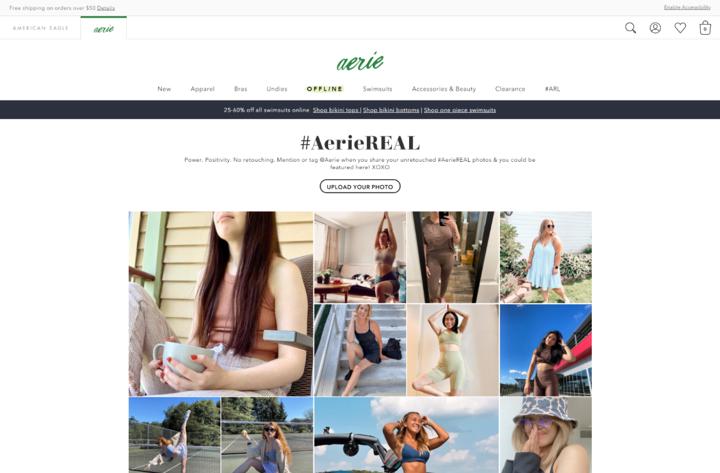
As a retail marketer, UGC is huge. It helps consumers better understand your products and serves as a shining endorsement. Using UGC strategically during new customer nurturing, retargeting, and at other points in the post purchase process can help turn one time buyers into lifetime customers.
Sometimes, just seeing a representation of a product on a body that looks like yours is enough to make a sale. And brands can lean on their community to showcase their products exactly how they really use them.
How UGC Affects Shopper Behavior
User generated content makes people more likely to purchase. By seeing an item “in the wild” per se, users can see that someone is really using the product, how it looks when it’s not styled or in perfect lighting, the quality of the product, and the ways they can use it. 92% of consumers trust recommendations from others over branded content and today’s consumers use reviews and testimonials more than other trust elements like awards or brand names.
Specifically, 93% of shoppers say that UGC helps them make purchasing decisions, and for retail marketers, user generated content is a win-win-win. You get to market your products using your customers’ authentic voices, you get a bonus testimonial because sharing a product is inherently a stamp of approval, and your customers get visibility to their personal accounts.
How Brands are Successfully Using UGC for Retail Email Marketing
Many fashion and retail brands are already using UGC on social, so pivoting to email marketing isn’t a huge lift. It’s an easy way to repurpose content that you didn’t even have to create, plus, your customers will love being featured and getting their image out there.
Brands are leveraging content creators and their ability to style their products as a marketing strategy, in turn lifting the influencer or customer’s reach and expanding their own audiences. Retail brands are using organically sourced content and partnering with influencers for brand partnerships to grow with engaged audiences.
Ready to create customized, branded post purchase order tracking emails (featuring UGC)? Take a look at the Wonderment + Klaviyo ecommerce order tracking integration for Shopify and try it free today.
10 Ways Brands use UGC to Improve Retail Email Marketing Performance
Since brand engagement improves by 28% when companies use both brand images and user-generated content in their email and social media efforts, it’s wise to take an intentional effort to encourage customers to share their stories, images, and videos with you using hashtags. In retail email marketing campaigns, UGC can increase CTRs by 300%.
Here are ten ways to use user generated content in ecommerce marketing email campaigns to build brand awareness, get new UGC, create lifetime customer loyalty, and improve retail sales.
1. Post purchase thank you emails/welcome emails
Right after your customer makes a purchase, take that as an opportunity to say thank you, introduce them to your loyalty program, offer a discount, and provide them with helpful information to best use your product or service. You can even use a customer’s helpful content as part of your new customer email welcome flow.
Here, Farm Rio includes a space in their welcome email to tag #FARMRIOLOVERS with a link to follow them on social media.
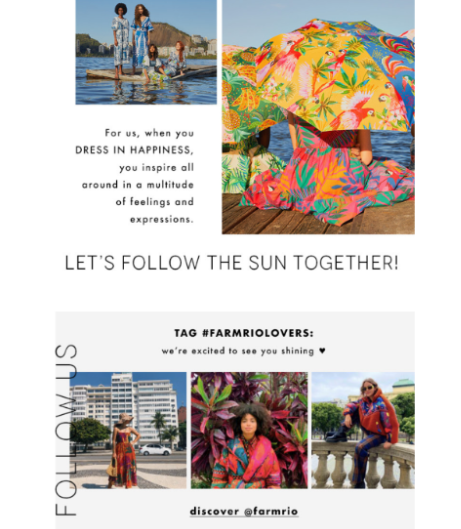
2. Promotional emails
In this Crate + Barrel email offering a Summer free shipping promotion, they include real user reviews, helpful guides, and displays of the products in use. User reviews are a form of user-generated content and can be pulled from your website, Amazon or other resellers, or anywhere else you receive feedback, like social media.
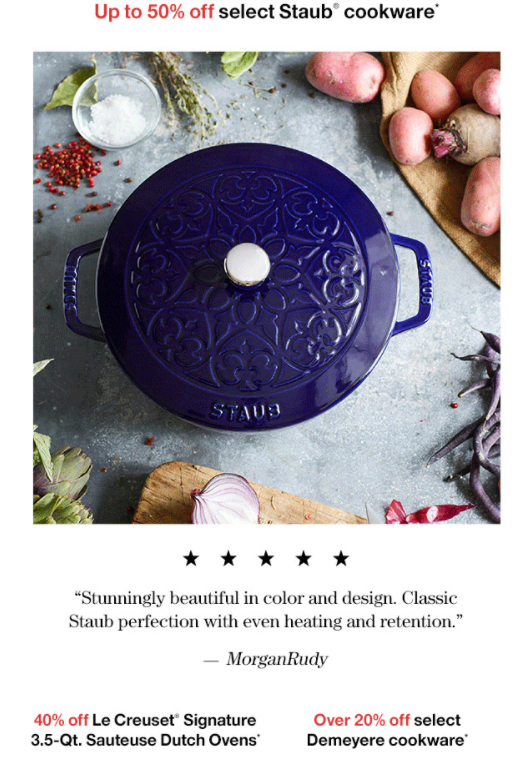
3. Loyalty program emails
Aerie creatively uses UGC in this loyalty program promotional email. The idea here is that the brand is showing other users, like me, who are part of the loyalty program, as a brand community building strategy.
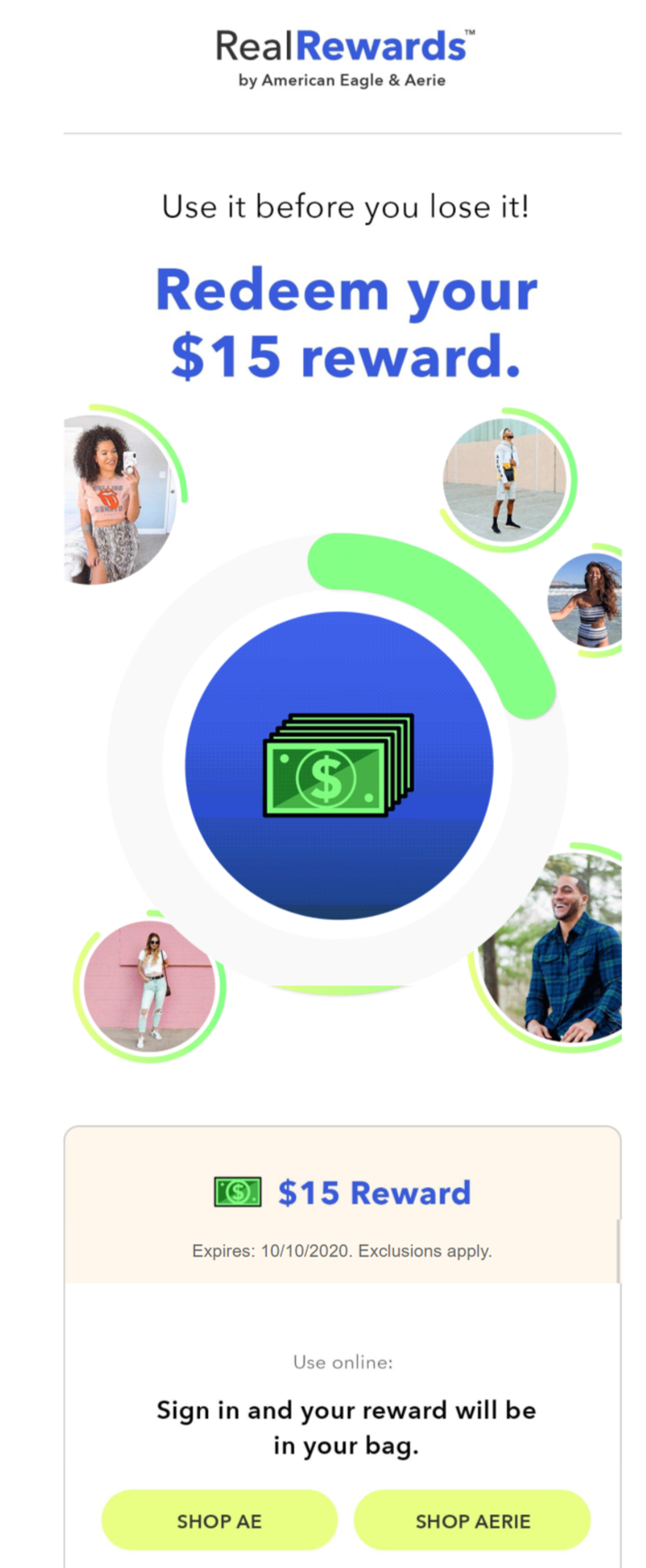
4. Abandoned cart recovery emails
While this email isn’t a direct abandoned cart recovery email, it’s still targeting me to purchase new items based on my history and is a part of the abandoned cart recovery email flow. It doesn’t take a direct approach, though. By showcasing a user’s style edit with actionable advice, then following up with style pieces that match this edit, Etsy is helping me imagine these items and how they could be styled.

For more abandoned cart email tips, check out these abandoned cart email templates + examples.
5. Testimonials/reviews
Emails are a great opportunity to share product reviews. Product review email examples, like the Crate + Barrel example and the Tea Collection examples below include the product right alongside the review and rating to add more credibility from real users of the product.
Make sure to include easy shop buttons and try pairing reviews with promotions. You can also customize emails with a customer’s size or preferences if you have that data to work with.
Tea Collective includes a CTA for readers to send in their own reviews— they know that you should always be collecting feedback, optimizing, and sending updates to be successful in post purchase retail marketing.

6. Social media and brand awareness campaigns
User generated content in emails can be used at any part of the retail customer journey. Here, Nekktar features customers in a special branded email campaign focused on Pride and how their shoppers are using their products and participating in community events. This email combines editorial content with UGC, social media posts, and upcoming events.

7. Contests
Contests are a way to incentivize customers to share their photo and video content with a chance to be featured and win prizes if chosen. Use email to promote social media contests and encourage readers to share the contest with friends and family, like this promotion from European Wax Center.

8. Gain new social media followers
Beauty and haircare brand BREAD has perfected their UGC email strategy. They feature customer posts as a way to attract new social media followers and include a mix of discounts and social media calls to action in their post-signup email nurturing campaigns.
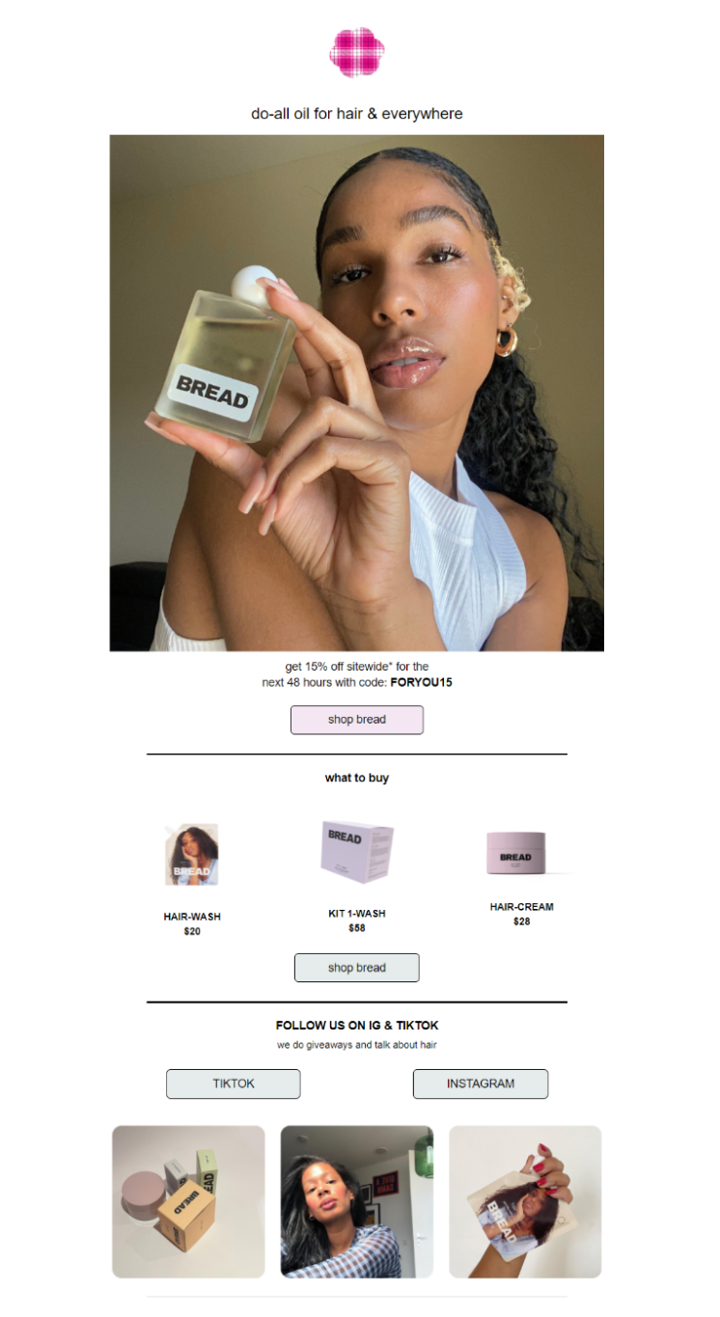
9. Showcase brand partners and gain new audiences of followers
This email from Minted, a stationery company, serves many purposes. It includes several partner images that are helping to sell the Summer stationery collection that have been curated into a collage, along with CTAs to shop the collection.

10. Gather data and insights
Try using UGC to learn more about your customer’s needs. Include a poll where you find out if they are more interested in beauty products or skincare. Or becoming a subscriber versus sticking with individual purchases. Or the larger sport water bottle versus the to-go option.
Then, tailor your future campaigns based on the click activity.
When you go to create your next retail email marketing campaign, start with your tagged mentions on social media or begin prioritizing social media testimonials and sharing now, so that you can use the content you get in a future email campaign.
Since UGC has the potential to increase click through rates by 300%, consider that metric for your next email campaign. If your existing emails are hitting a plateau or you are looking for a boost in performance, adding brand identity, user content, and up-to-date order tracking can take your email program to the next level.
To start sending beautifully branded retail marketing emails, explore the Wonderment + Klaviyo Shopify app now.





